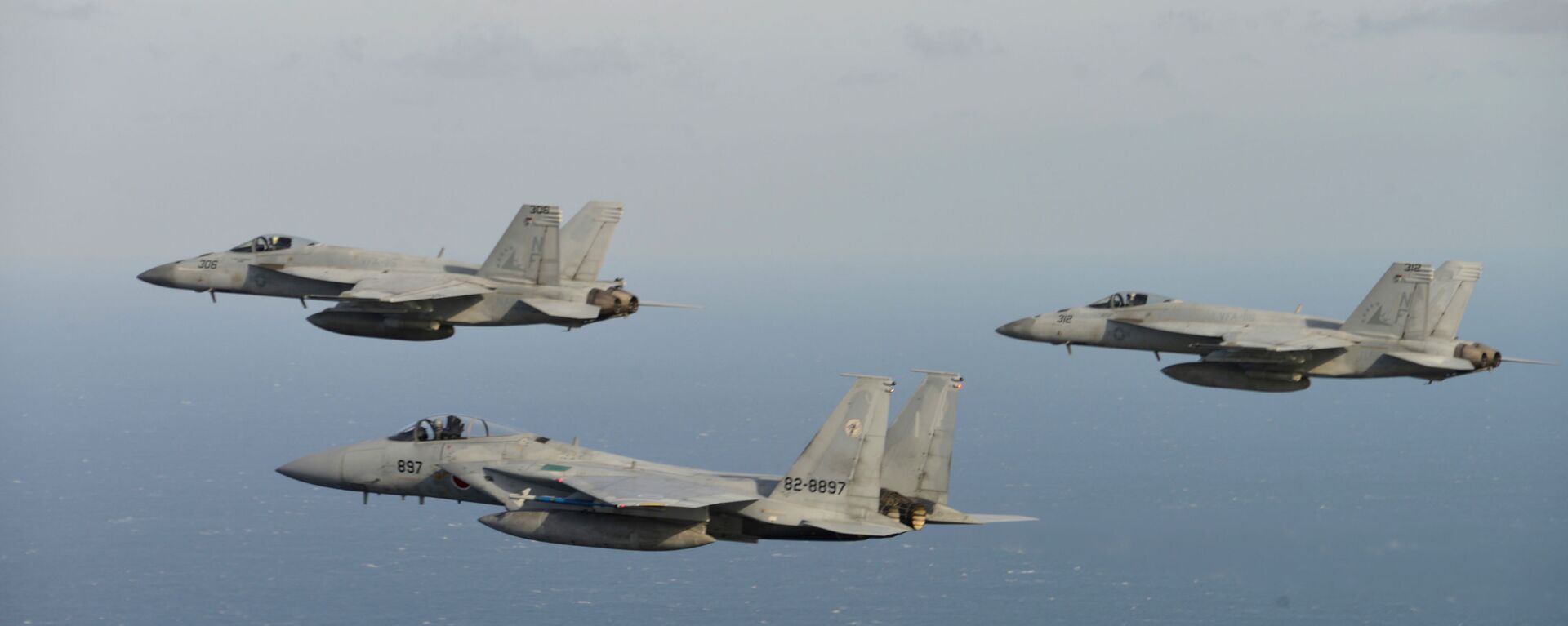https://sputnikglobe.com/20230921/will-west-draw-japan-into-militarization-with-uk-italy-6th-gen-fighter-project-1113552937.html
Will West Draw Japan Into Militarization With UK-Italy 6th-Gen Fighter Project?
Will West Draw Japan Into Militarization With UK-Italy 6th-Gen Fighter Project?
Sputnik International
Japan's 1947 constitution rejects the militarism that led the empire to disaster in the Second World war. But in recent years, the Tokyo government has sought to relax the prohibition on closer military co-operation with the West.
2023-09-21T15:25+0000
2023-09-21T15:25+0000
2023-09-21T15:25+0000
world
united kingdom (uk)
japan
italy
mitsubishi heavy industries
mitsubishi aircraft corp
mitsubishi
bae systems
https://cdn1.img.sputnikglobe.com/img/07e7/09/15/1113555179_0:0:3072:1728_1920x0_80_0_0_363bf8be33ed7b8a1210485d0fcf27cd.jpg
Japan may break its post-WWII rules against arms exports by joining NATO members the UK and Italy in a 6th-generation fighter jet project.Local sources told media on Thursday that the UK would be chosen as the headquarters for the Global Combat Air Programme (GCAP) development program.The Japanese defense procurement agency insisted that discussions about the location of the project's HQ were still "ongoing" and refused to comment further, while the British Ministry of Defence said that "no final decisions have been made on the locations and we will not comment on speculation."The collaboration, launched in December 2022, will merge the British Tempest future fighter project with Japan's Mitsubishi-FX. The program has set ambitious targets of building the first prototype in 2029, flight-testing in 2030 and producing in 2031.Japan's IHI Corporation has been contracted to develop the jet's engine, despite never having built a military jet power plant before.But that could run afoul of Japan's US-drafted post-war constitution, which puts limits on the production and export of weapons and mandates the role of the armed forces to purely self-defense.In recent years, a succession of Liberal Democratic Party governments have sought to re-write that charter to allow overseas deployments in support of US-led military interventions, currently forbidden by article 9.Under pressure from the West, Tokyo is now seeking to loosen the restrictions on arms exports too. Japanese military suppliers argue that doing so could help recoup research and development costs and would be "effective in ensuring the growth of the defense industry through the expansion of a defense equipment market."The Tempest was itself a joint effort between BAe systems, Rolls Royce and the British subsidiaries of Italian aerospace firm Leonardo — formerly Finmeccanica — and pan-European guided missile producer MBDA.The United Arab Emirates (UAE) and Saudi Arabia have also expressed interest in the future aircraft, but will not be closely involved in its development. The Tempest would have been the first all-British jet fighter program since the BAC Lightning, which entered service in 1960, or the Hawker Siddeley Harrier introduced in 1969. The SEPECT Jaguar — now only operated by the Indian Air Force — was an Anglo-French design, while the Panavia Tornado was a UK-German-Italian project and the Eurofighter Typhoon included Spain as well.Japan's only truly indigenous supersonic jet fighter was the Mitsubishi F-1, in service from 1978 to 2006. The Japan Air Self-Defense Force now flies the US-made F-15 Eagle and Mitsubishi F-2, a locally-built variant of the US F-16 Eagle.Japan modernized its feudal-style military system during the Meiji period under the long reign of emperor Mitsuhito, who also reformed the state into a constitutional monarchy with a prime minister heading the government.The country militarized heavily during the period between the two world wars, when it sought to dominate the Pacific region in rivalry with fellow imperialist powers the US, Great Britain, France and the Netherlands, becoming a military dictatorship in the process. Its occupations of north-eastern China and Korea were marked by genocidal atrocities which continued throughout the Second World War.Since the post-war occupation, Japan has played host to numerous US bases. Their presence on the island of Okinawa has prompted decades of protests by local residents angered at a string of unpunished rapes and murders by US servicemen and concerns about the safety of air operations, especially with the accident-prone MV-22 Osprey tiltrotor aircraft.
https://sputnikglobe.com/20230119/japan-reverts-to-militarism-as-us-prepares-to-use-tokyo-against-china-scholars-say-1106485309.html
https://sputnikglobe.com/20230802/north-korea-accuses-japan-of-reverting-to-militarism-1112341232.html
united kingdom (uk)
japan
italy
Sputnik International
feedback@sputniknews.com
+74956456601
MIA „Rossiya Segodnya“
2023
James Tweedie
https://cdn1.img.sputnikglobe.com/img/07e4/08/1c/1080307270_0:3:397:400_100x100_80_0_0_7777393b9b18802f2e3c5eaa9cbcc612.png
James Tweedie
https://cdn1.img.sputnikglobe.com/img/07e4/08/1c/1080307270_0:3:397:400_100x100_80_0_0_7777393b9b18802f2e3c5eaa9cbcc612.png
News
en_EN
Sputnik International
feedback@sputniknews.com
+74956456601
MIA „Rossiya Segodnya“
Sputnik International
feedback@sputniknews.com
+74956456601
MIA „Rossiya Segodnya“
James Tweedie
https://cdn1.img.sputnikglobe.com/img/07e4/08/1c/1080307270_0:3:397:400_100x100_80_0_0_7777393b9b18802f2e3c5eaa9cbcc612.png
japanese constitutional ban on militarisation, gcap 6th generation fighter project, japan nato us military cooperation
japanese constitutional ban on militarisation, gcap 6th generation fighter project, japan nato us military cooperation
Will West Draw Japan Into Militarization With UK-Italy 6th-Gen Fighter Project?
Japan's 1947 constitution rejects the militarism that led the empire to disaster in the Second World War. But under Western influence, the Tokyo government has sought to relax the prohibition on closer military cooperation with the West.
Japan may break its post-WWII rules against arms exports by joining NATO members the UK and Italy in a 6th-generation fighter jet project.
Local sources told media on Thursday that the UK would be chosen as the headquarters for the
Global Combat Air Programme (GCAP) development program.
"The headquarters will be in Britain, but for the sake of balance, someone from Japan could head it," said one anonymous source.
The Japanese defense procurement agency insisted that discussions about the location of the project's HQ were still "ongoing" and refused to comment further, while the British Ministry of Defence said that "no final decisions have been made on the locations and we will not comment on speculation."
The collaboration, launched in December 2022, will merge the British Tempest future fighter project with Japan's Mitsubishi-FX. The program has set ambitious targets of building the first prototype in 2029, flight-testing in 2030 and producing in 2031.
Japan's IHI Corporation has been contracted to develop the jet's engine, despite never having built a military jet power plant before.

19 January 2023, 12:35 GMT
But that could run afoul of Japan's US-drafted
post-war constitution, which puts limits on the production and export of weapons and mandates the role of the armed forces to purely self-defense.
In recent years, a succession of Liberal Democratic Party governments have sought to
re-write that charter to allow overseas deployments in support of US-led military interventions, currently forbidden by article 9.
Under pressure from the West, Tokyo is now seeking to loosen the restrictions on arms exports too. Japanese military suppliers argue that doing so could help recoup research and development costs and would be "effective in ensuring the growth of the defense industry through the expansion of a defense equipment market."
"We are aware that many Japanese companies view defense contracts as a risk to their reputation," admitted Shuji Yuge, the Japanese Defense Ministry's director for the GCAP project. But he argued that "through the GCAP, the next generation of engineers will be nurtured who can work head-to-head with their foreign counterparts. This should have a broad spillover effect on the whole economy."
The Tempest was itself a joint effort between BAe systems, Rolls Royce and the British subsidiaries of Italian aerospace firm Leonardo — formerly Finmeccanica — and pan-European guided missile producer MBDA.
The United Arab Emirates (UAE) and Saudi Arabia have also expressed interest in the future aircraft, but will not be closely involved in its development.
The Tempest would have been the first all-British jet fighter program since the BAC Lightning, which entered service in 1960, or the Hawker Siddeley Harrier introduced in 1969. The SEPECT Jaguar — now only operated by the Indian Air Force — was an Anglo-French design, while the Panavia Tornado was a UK-German-Italian project and the Eurofighter Typhoon included Spain as well.
Japan's only truly indigenous supersonic jet fighter was the Mitsubishi F-1, in service from 1978 to 2006. The Japan Air Self-Defense Force now flies the US-made F-15 Eagle and Mitsubishi F-2, a locally-built variant of the US
F-16 Eagle.Japan modernized its feudal-style military system during the Meiji period under the long reign of emperor Mitsuhito, who also reformed the state into a constitutional monarchy with a prime minister heading the government.
The country militarized heavily during the period between the two world wars, when it sought to dominate the Pacific region in rivalry with fellow imperialist powers the US, Great Britain, France and the Netherlands, becoming a military dictatorship in the process. Its occupations of north-eastern China and Korea were marked by genocidal atrocities which continued throughout the Second World War.
Since the post-war occupation, Japan has played host to numerous US bases. Their presence on the island of Okinawa has prompted decades of protests by local residents angered at a string of unpunished rapes and murders by US servicemen and concerns about the safety of air operations, especially with the accident-prone
MV-22 Osprey tiltrotor aircraft.





